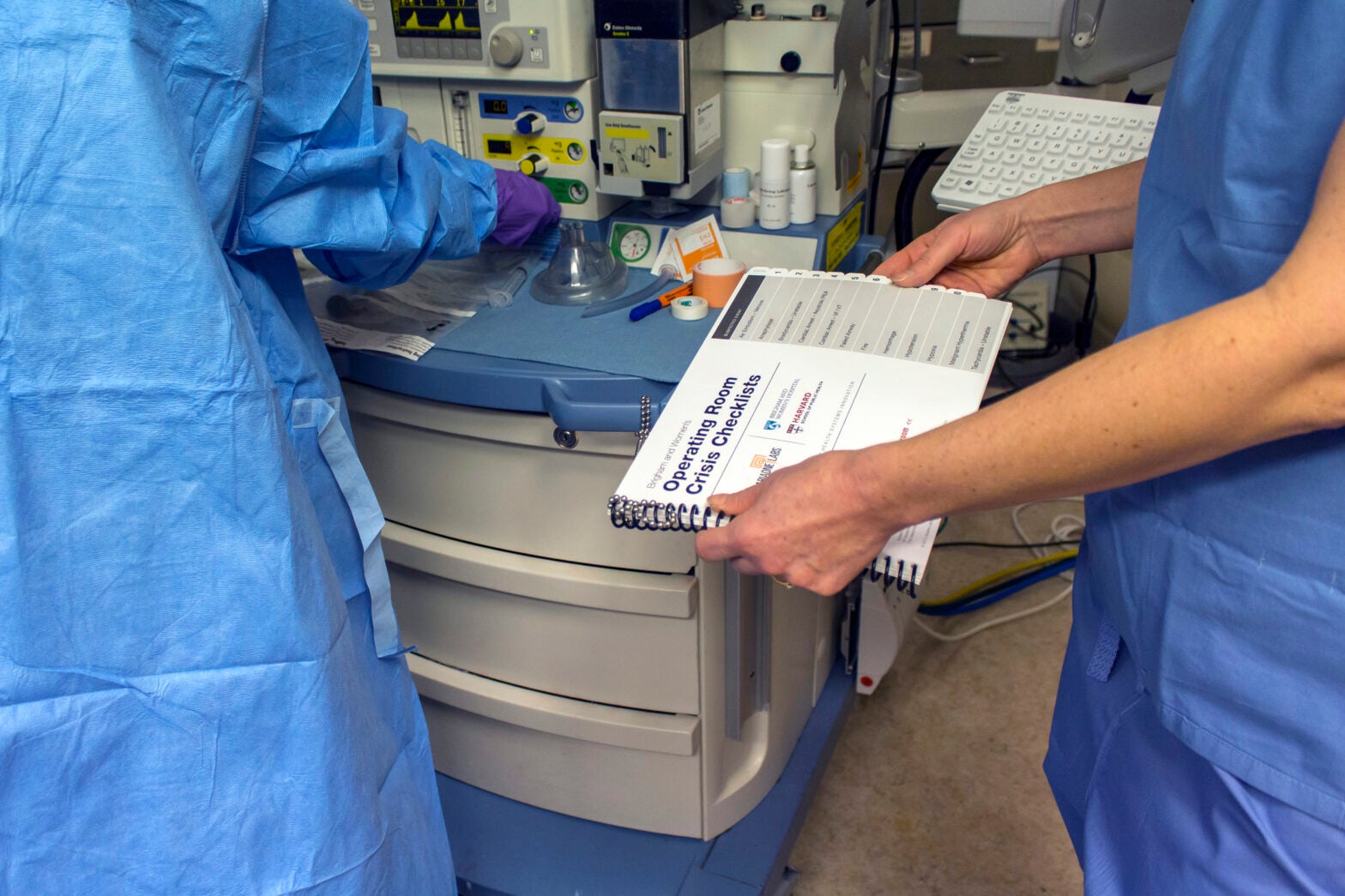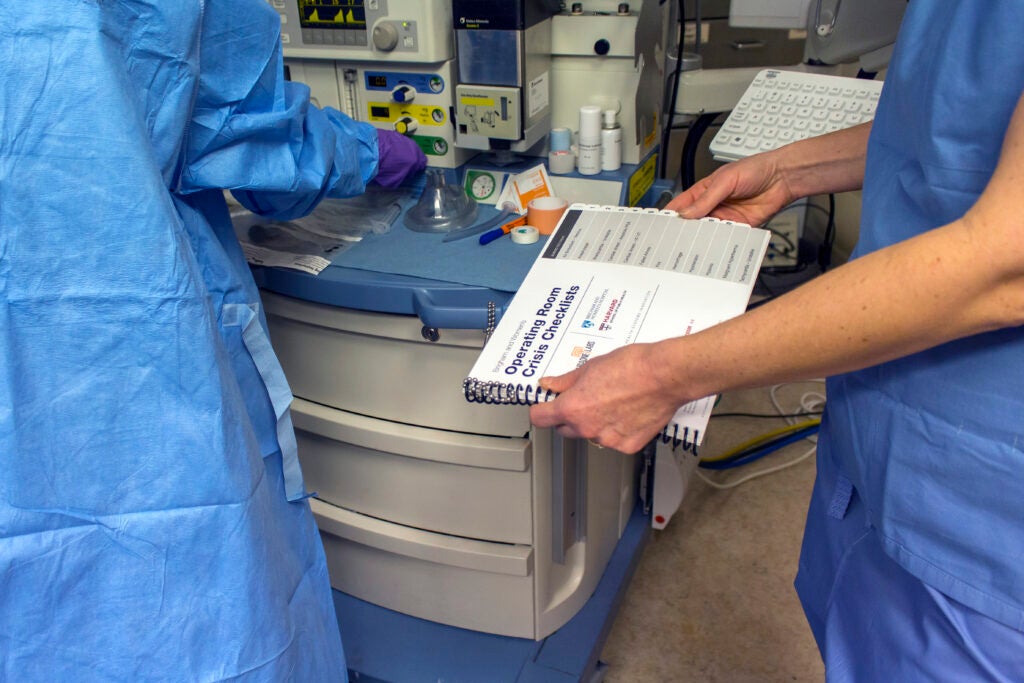Checklist updates drew on a multidisciplinary panel of experts
When a medical crisis strikes in the operating room, there is not a second to waste. Surgical teams need to be prepared with the knowledge, supplies, and processes to respond quickly and efficiently to cases of cardiac arrest, hemorrhage, failed airways, and more.
It has been well-documented that cognitive aids, such as checklists, can support operating room teams in appropriately responding in moments of crisis. In 2011, Ariadne Labs developed the Operating Room Crisis Checklists to provide easy-to-use, customizable Checklists to address the most frequent crises encountered in the OR. Now, 12 years later, the team has revisited the tools to produce a digitized, customizable suite of Checklists optimized for both hard-copy and mobile device access that they hope will encourage more health systems to adopt these life-saving tools.
The update process drew on the expertise of an international review board of leading physicians, pharmacists, and patient safety leaders, many of whom were the leading experts in a particular clinical event. While the team at Ariadne Labs brought content expertise, they knew it would be critical to involve a multidisciplinary panel of experts to ensure that the information provided was comprehensive and representative of current clinical practice.
“When we first started to seek out experts to contribute to the work, we weren’t sure how many would respond,” said Alex Hannenberg, MD, an anesthesiologist and Senior Research Scientist at Ariadne Labs. Dr. Hannenberg has played a critical role in leading the development and implementation of Operating Room Crisis Checklists. “What we found though, was that an overwhelming number of people were ready to volunteer their time and expertise to support this project – a testament to the value of these tools in operating rooms.”
Ultimately, the team at Ariadne Labs convened a group of more than 40 experts who took time to carefully review the content of the Checklists as they were produced, offering their expertise to be certain they reflected current best practice.
“Teamwork is a foundational hallmark of patient safety. The acute management of a medical crisis involves several disciplines, and the development of crisis checklists involves leveraging the knowledge of experts,” said Alexander Arriaga, MD, MPH, ScD, an Attending Anesthesiologist at Brigham and Women’s Hospital who served on the expert review board and led work to develop the original checklists in 2011. “The Ariadne Labs Operating Room Crisis Checklists were always viewed as team checklists, and it is wonderful that the updated version has continued in this tradition.”
Sara J. Hyland, PharmD, BCCCP, led a team of 14 clinical pharmacists to provide expert reviews and recommendations to optimize the medication-related components of the checklists. Hyland is a clinical pharmacist in perioperative and emergency medicine at OhioHealth Grant Medical Center. “Some of these intraoperative crises involve a very complex host of high-risk medications, and pharmacists are well poised to advise on dosing, standard concentrations and dilutions, comparative efficacy, and other aspects of medication safety and emergency preparedness,” said Hyland.
The newly digitized Checklists allow users to easily customize key fields in a dedicated editing portal and can add important hospital contact information, make dosing instructions compatible with local practice, or remove advanced therapeutic options that may not be available in all settings. By design, not all fields are customizable, to ensure that the core, clinically vetted content of the Checklist remains intact.
“The Checklists are key to improving results in different crisis situations, as team members do not forget important actions to take,” said Fernando Cassinello, editor of the SENSAR Crisis Manual on Anesthesia and Critical Patients. “This process allowed multiple experts to participate and share their knowledge, making for a better final product.”
In addition to updating the content and format, the team was able to add an additional five Checklists to the compendium, for a total of 17 Checklists, to help address more of the most frequently occurring crisis events.
The digital Checklists are accompanied by a two page clinical use guide to reflect lessons learned over the decade of checklist use, such as which Checklist to use in what types of situations, what to do when a patient is experiencing multiple problems at once, how to engage the entire OR team in checklist use, and other key lessons learned.
“These checklists are the first step in empowering intraoperative clinicians to provide the best possible care during a crisis. Patients benefit when clinicians have what they need to immediately assess and respond to unanticipated complications in a safe and efficient manner,” said Hyland.
The Checklists are available free of charge to any health system interested in implementing them into their practice. The current enhancements were supported by a grant from the Doctor’s Company Foundation.
“Our goal is to spread these tools as widely as possible and get them into as many operating rooms as we can,” said Dr. Hannenberg. “Thankfully, crisis events are not occurring in operating rooms every day, but that is also part of the challenge in ensuring that clinicians remain prepared to take the necessary action in the rare cases when these events do occur. These tools are intended to help fill that gap so that clinicians can act quickly when there’s no time to lose.”




